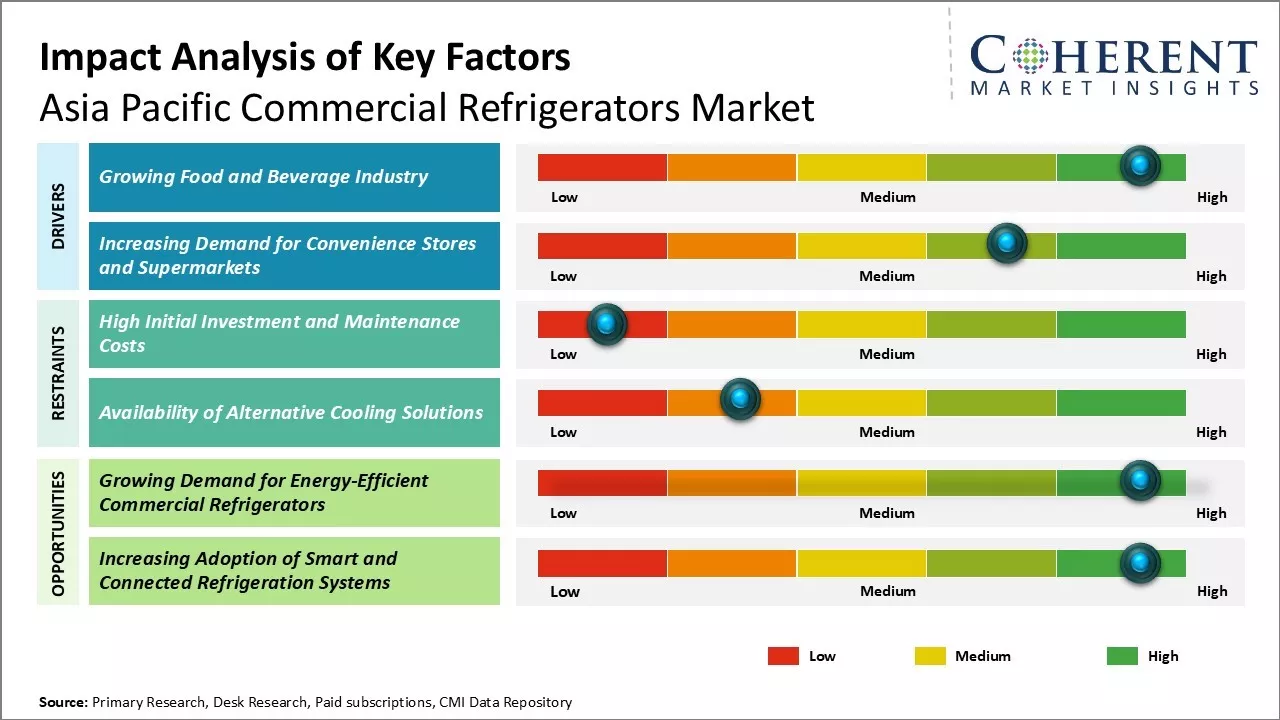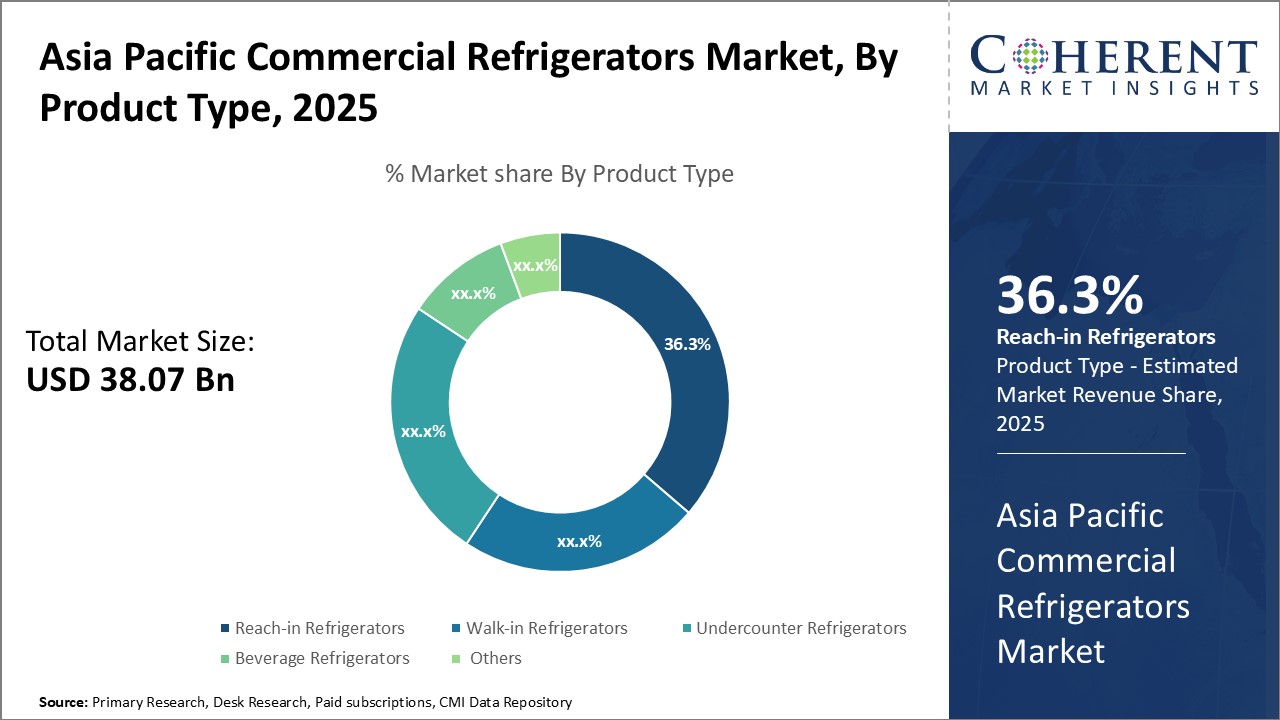Asia Pacific Commercial Refrigerators Market Size and Trends
The Asia Pacific commercial refrigerators market is estimated to be valued at US$ 38.07 Bn in 2025 and is expected to reach US$ 67.42 Bn by 2032, exhibiting a compound annual growth rate (CAGR) of 8.5% from 2025 to 2032.

Discover market dynamics shaping the industry: Download Free Sample
The Asia Pacific commercial refrigerators market is witnessing significant growth driven by increasing organized retail and food retail sectors mainly in developing economies. Growing food and beverage industry along with expanding modern trade in countries such as India, China is bolstering the demand for commercial refrigeration products. Rapid urbanization coupled with growing working population and rising disposable income levels is also augmenting the market expansion through 2032.
Market Driver - Growing Food and Beverage Industry
The food and beverage industry across the Asia Pacific region has been witnessing significant growth over the past few years with increasing disposable income and changing dietary habits of consumers. Countries like China, India, Japan, and others are producing and consuming more food than ever before which is creating a favorable environment for the commercial refrigerators market.
The growing demand for processed and packaged food items like snacks, dairy products, and ready to eat meals is driving the need for refrigerator units in grocery shops, departmental stores, and quick service restaurants. Many international as well as local food and beverage companies have been investing heavily in setting up new production plants, expanding their distribution networks across tier 1 as well as tier 2 and tier 3 cities. This is generating substantial requirement for cold storage facilities to store and transport perishable items safely without spoilage.
Consumers are increasingly opting for frozen pizzas, burgers, and desserts due to convenience factor which need to be stored in commercial refrigeration units. The dairy industry is another major user of commercial refrigerators as milk, yogurt, and other dairy products require consistent cooling temperatures during storage and transportation to maintain quality and shelf life.
The restaurants business from street food stalls to fine dining restaurants is proliferating rapidly in countries like India, Vietnam, and Indonesia due to Western influence and tourism growth. The growing organized retail sector is also pushing the demand as supermarkets and hypermarkets need reliable refrigerator display units to attract customers.
Market Concentration and Competitive Landscape

Get actionable strategies to beat competition: Download Free Sample
Increasing Demand for Convenience Stores and Supermarkets
The Asian region is experiencing rising urban population coupled with increasing disposable incomes which is driving more consumers to opt for convenience products and services to save time. This has pushed the growth of convenience stores, small grocery shops and neighborhood supermarkets significantly over last few years. Such stores provide easy access to daily need consumer items as well as food and beverages to time strapped customers.
These modern convenience outlets are well equipped with commercial refrigerator display units of various types and sizes based on their requirement. While small convenience stores use basic under-counter refrigerator units to showcase beverages and dairy items, larger neighborhood supermarkets rely on walk-in cooler rooms and freezer systems to store delicate fruits and vegetables, meats, seafood and other products in controlled thermal conditions for longer shelf life.
As more women are joining the workforce, the need for convenient one-stop shopping experience close to their homes or offices has increased manifold. Supermarkets are stocking up not just staples but also value-added food items, snacks and ready to eat meals to cater to this demand. This trend has empowered the retail sector to expand aggressively across cities as well as tier 2 and tier 3 towns where availability of organized retailers was limited earlier.
Moreover, the ready availability of affordable refrigerator units today and technological advancements allowing higher energy efficiency compared to earlier units are encouraging smaller neighborhood shops as well as start-ups engaged in online food delivery business to utilize commercial refrigeration to showcase and store food items under safe temperatures-controlled environment. All these factors are fueling the commercial refrigerators demand strongly in the region.
Key Takeaways from Analyst:
The rapidly growing food and beverage industry across developing countries such as India and Indonesia will be a major driver of demand for commercial refrigerators used by restaurants, hotels, retail stores and other food businesses. Rapid urbanization and rising disposable incomes are leading to more food outlets and growing demand for chilled and frozen food, which require commercial refrigeration systems.
China will continue to dominate the Asia Pacific commercial refrigerators market owing to its huge population size and rapidly growing food service sector. Developing regions such as Southeast Asia are expected to see strong demand as food businesses look to augment their infrastructure. However, high initial investment costs could limit the adoption of advanced commercial refrigeration units, especially among price-sensitive small businesses. On the other hand, ongoing replacements and upgrades of aging equipment will provide opportunities for vendors.
Rising energy consumption of commercial refrigerators remains a key challenge due to increasing ambient temperatures across the region. Players need to focus on introducing energy-efficient refrigerator models with advanced features such as inverter technology and LED lighting to reduce operational costs. Competition from local white goods manufacturers offering cost-effective refrigeration solutions could also limit the pricing flexibility of international brands.
Market Challenge - High Initial Investment and Maintenance Costs
The high initial cost of purchasing commercial refrigerators is a major challenge for the Asia Pacific commercial refrigerators market. Commercial refrigerators require a sizable capital investment, which can range anywhere from tens of thousands to hundreds of thousands of dollars depending on the size and features of the unit. The high performance insulation and advanced cooling technologies that enable commercial refrigerators to safely store large volumes of perishable goods also contribute to their high price tags. Additionally, commercial refrigerators require routine maintenance and repairs to address issues like compressor failures or faulty door seals. The costs of service contracts and repairing units can place an ongoing financial burden on businesses. While businesses recognize the necessity of commercial refrigerators, the high upfront and operating expenses can discourage upgrades and negatively impact the sales potential of new, more advanced models. This phenomenon poses a challenge to the growth aspirations of manufacturers in this marketplace.
Growing Demand for Energy-Efficient Commercial Refrigerators
There is a growing demand in the Asia Pacific region for energy-efficient commercial refrigerators. With energy costs on the rise and businesses looking to reduce their carbon footprint, commercial operators are increasingly prioritizing the purchase of refrigeration units that minimize energy consumption. This presents an opportunity for manufacturers to develop advanced refrigerators with innovative insulation technologies, digital inverters, and auto-closer doors. Such innovations allow units to precisely maintain internal temperatures while using less electricity overall. Manufacturers that can offer units with lower lifetime energy and utility costs will gain an edge in the Asia Pacific commercial refrigerators market. Going green supports sustainability goals and improves the profitability of business customers through energy savings.

Discover high revenue pocket segments and roadmap to it: Download Free Sample
Insights By product type - Convenience and efficiency drive demand for reach-in refrigerators
In terms of product type, the reach-in refrigerators segment is expected to contribute 36.3% share of the market in 2025 owing to its convenience and efficiency. Reach-in refrigerators are freestanding appliances with hinged doors that allow users to easily access food and beverage items stored inside without having to bend down. Their height provides ample storage space while keeping contents at convenient reach. This makes them very suitable for commercial kitchens where chefs and staff need to access ingredients regularly without obstructing workspace. Reach-ins also offer efficient organization of goods through adjustable wire shelves and drawers. Perishables can be neatly separated based on type and use. Their sturdy construction ensures items remain fresh longer while minimizing unnecessary opening of doors that wastes energy.
Insights By distribution channel - Direct engagement enhances customer experience in direct sales channel
In terms of distribution channel, the direct sales segment is expected to contribute the 62.4% share of the market in 2025. Companies utilizing the Direct Sales model can strategically engage customers at each step – from initial needs assessment and demonstration of product features to on-site installation and after-sales support. This allows for a more personalized experience catered to individual business requirements. Direct field sales teams develop strong relationships and trust with clients through regular interactions. They gain deep understanding of customers to recommend most suitable equipment and solutions. Any issues can also be promptly addressed to maximize uptime. The direct engagement model ensures buyers receive best value through competitive pricing negotiated directly with manufacturers.
Insights By end user - Convenience drives demand from the food service sector
In terms of end user, the food service segment is expected to contribute the 46.8% share of the market in 2025. Commercial kitchens require reliable, heavy-duty refrigeration units that can withstand intensive daily use over long operating hours. Reach-in and walk-in refrigerators suitable for Food Service provide ample, well-organized storage for large volumes of ingredients and prepared items. Their adjustable temperature zones allow precise temperature control for meats, seafood, produce and more. Digital controls with alerts improve monitoring. Seamless integration of refrigeration into workflow maximizes efficiency. Restaurants and cafes benefit from the convenience of conveniently accessing foods without disruptions. This spares time and ensures quick, consistent food preparation at large scales. The dependability of commercial-grade units suitable for Food Service meets rigorous industry needs.
Market Report Scope
Asia Pacific Commercial Refrigerators Market Report Coverage
| Report Coverage | Details | ||
|---|---|---|---|
| Base Year: | 2024 | Market Size in 2025: | USD 38.07 Bn |
| Historical Data for: | 2020 To 2024 | Forecast Period: | 2025 To 2032 |
| Forecast Period 2025 to 2032 CAGR: | 8.5% | 2032 Value Projection: | USD 67.42 Bn |
| Segments covered: |
|
||
| Companies covered: |
Daikin Industries, Fukushima Industries Corporation, GE Appliances, Haier Group, Hoshizaki Corporation, Hitachi, LG Electronics, Liebherr Group, Midea Group, Panasonic, True Manufacturing Co., Inc., Voltas Limited, Marmon Holdings, Inc., Electrolux AB, and Samsung Electronics |
||
| Growth Drivers: |
|
||
| Restraints & Challenges: |
|
||
Uncover macros and micros vetted on 75+ parameters: Get instant access to report
Market Segmentation
- Product Type Insights (Revenue, US$ Bn, 2020 - 2032)
-
- Reach-in Refrigerators
- Walk-in Refrigerators
- Undercounter Refrigerators
- Beverage Refrigerators
- Others
- Distribution Channel Insights (Revenue, US$ Bn, 2020 - 2032)
-
- Direct Sales
- Indirect Sales (e.g., distributors, dealers)
- End User Insights (Revenue, US$ Bn, 2020 - 2032)
-
- Food Service
- Grocery Stores and Supermarkets
- Healthcare
- Hospitality
- Others
- Key Players Insights
- Daikin Industries
- Fukushima Industries Corporation
- GE Appliances
- Haier Group
- Hoshizaki Corporation
- Hitachi
- LG Electronics
- Liebherr Group
- Midea Group
- Panasonic
- True Manufacturing Co., Inc.
- Voltas Limited
- Marmon Holdings, Inc.
- Electrolux AB
- Samsung Electronics
Share
Share
About Author
As an accomplished Senior Consultant with 7+ years of experience, Pooja Tayade has a proven track record in devising and implementing data and strategy consulting across various industries. She specializes in market research, competitive analysis, primary insights, and market estimation. She excels in strategic advisory, delivering data-driven insights to help clients navigate market complexities, optimize entry strategies, and achieve sustainable growth.
Missing comfort of reading report in your local language? Find your preferred language :
Transform your Strategy with Exclusive Trending Reports :
Frequently Asked Questions
EXISTING CLIENTELE
Joining thousands of companies around the world committed to making the Excellent Business Solutions.
View All Our Clients
